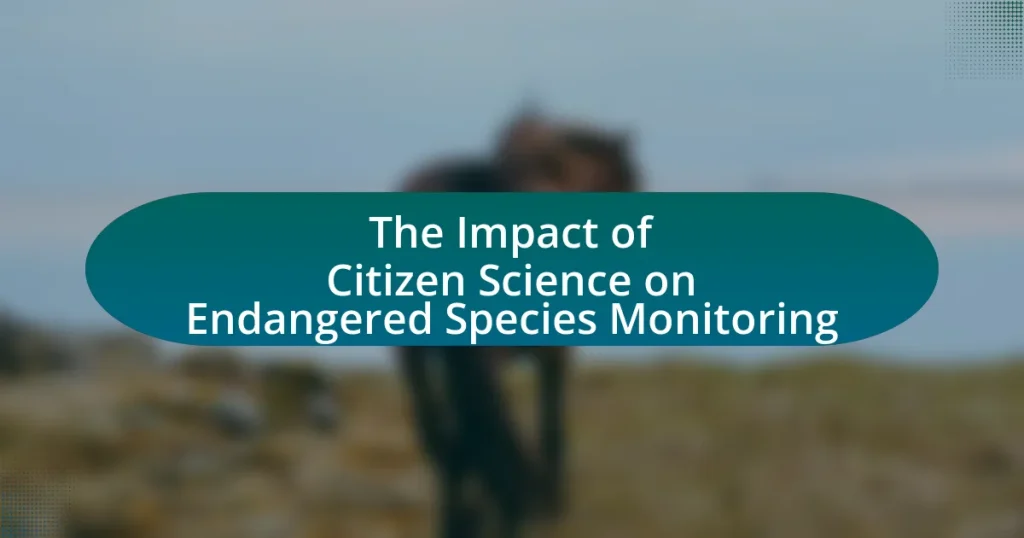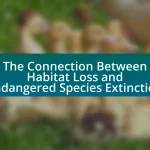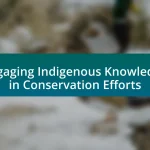Citizen science plays a crucial role in monitoring endangered species by enhancing data collection and fostering public engagement. Platforms such as iNaturalist and eBird enable volunteers to contribute valuable observations, resulting in comprehensive datasets that can match the quality of professional data. This collaborative approach not only aids in tracking species populations and distributions but also raises awareness about conservation issues. The article explores the contributions of citizen scientists, the technological tools utilized, the importance of monitoring endangered species, and the challenges faced in ensuring data quality and participant engagement. Additionally, it highlights best practices for sustaining citizen involvement in conservation efforts.
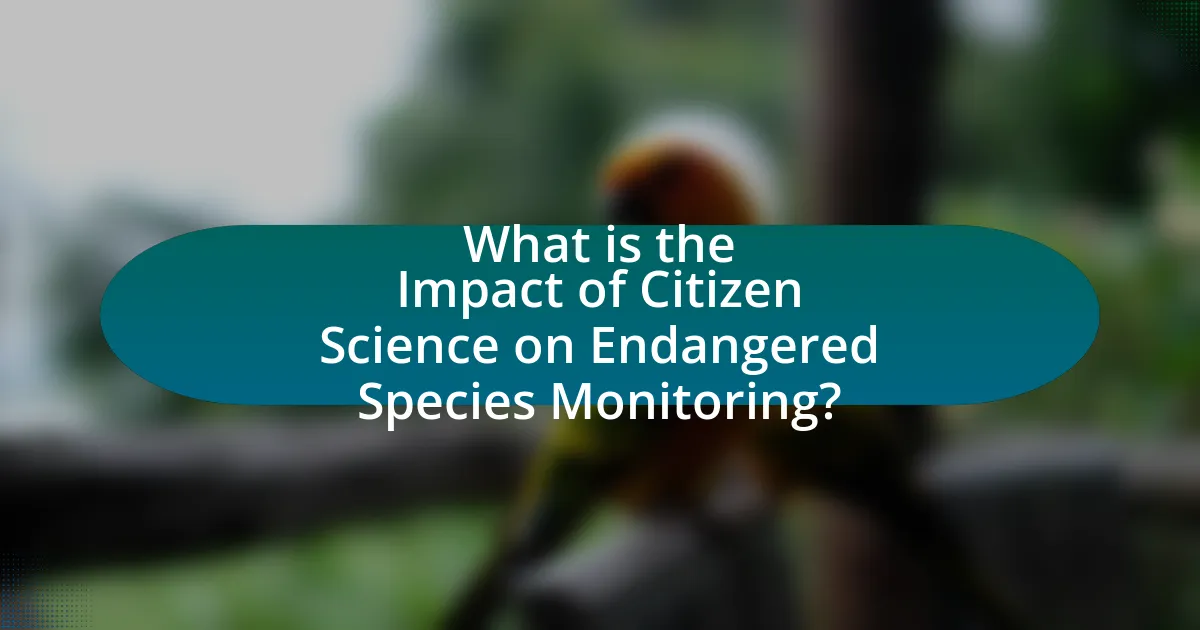
What is the Impact of Citizen Science on Endangered Species Monitoring?
Citizen science significantly enhances endangered species monitoring by increasing data collection efforts and public engagement. Through platforms like iNaturalist and eBird, volunteers contribute valuable observations, which can lead to more comprehensive species distribution maps and population assessments. A study published in the journal “Biological Conservation” found that citizen-collected data can match the quality of professional data, demonstrating that citizen science can effectively supplement traditional monitoring methods. This collaborative approach not only aids in tracking endangered species but also raises awareness and fosters conservation efforts among the public.
How does citizen science contribute to monitoring endangered species?
Citizen science significantly contributes to monitoring endangered species by engaging the public in data collection and observation efforts. This involvement increases the volume of data available for researchers, as citizen scientists can cover larger geographic areas and diverse habitats than professional scientists alone. For instance, projects like the Cornell Lab of Ornithology’s eBird platform have amassed millions of bird observations from volunteers, aiding in tracking population trends and distribution changes of various species. Such extensive datasets enhance the understanding of species’ status and inform conservation strategies, demonstrating the effectiveness of citizen science in biodiversity monitoring.
What roles do volunteers play in data collection for endangered species?
Volunteers play critical roles in data collection for endangered species by participating in field surveys, monitoring populations, and reporting sightings. These activities enhance the data available for conservation efforts, as volunteers often contribute significant time and effort, leading to increased data coverage and frequency. For instance, studies have shown that citizen science initiatives can yield large datasets that are comparable to those collected by professional scientists, thereby improving the understanding of species distribution and behavior. Additionally, volunteers often help in habitat assessments and contribute to public awareness, which is essential for conservation strategies.
How is technology utilized in citizen science for species monitoring?
Technology is utilized in citizen science for species monitoring through mobile applications, remote sensing, and data collection platforms. Mobile applications enable volunteers to report sightings and gather data on species distribution, while remote sensing technologies, such as satellite imagery and drones, provide critical habitat information and track changes over time. Data collection platforms, like eBird and iNaturalist, facilitate the aggregation and analysis of large datasets contributed by citizen scientists, enhancing the understanding of species populations and trends. These technological tools have been shown to significantly increase the volume and quality of data collected, as evidenced by studies indicating that citizen-generated data can match or exceed the accuracy of professional data in certain contexts.
Why is monitoring endangered species important?
Monitoring endangered species is crucial for conservation efforts and biodiversity preservation. By tracking population numbers, habitat conditions, and threats, conservationists can implement targeted strategies to protect these species. For instance, the International Union for Conservation of Nature (IUCN) reports that effective monitoring has led to the recovery of species such as the California condor, which increased from 27 individuals in 1987 to over 500 today due to focused conservation actions. This demonstrates that systematic monitoring not only informs conservation policies but also enhances the chances of species survival in the wild.
What are the consequences of failing to monitor endangered species?
Failing to monitor endangered species leads to increased risk of extinction and loss of biodiversity. Without regular monitoring, populations may decline unnoticed, resulting in irreversible damage to ecosystems. For instance, the International Union for Conservation of Nature (IUCN) reports that species like the Spix’s Macaw became extinct in the wild due to inadequate monitoring and conservation efforts. Additionally, the lack of data hampers effective conservation strategies, making it difficult to allocate resources efficiently and respond to threats such as habitat loss and climate change. This failure ultimately disrupts ecological balance and can have cascading effects on other species and human communities reliant on these ecosystems.
How does monitoring contribute to conservation efforts?
Monitoring contributes to conservation efforts by providing essential data on species populations, habitat conditions, and ecosystem health. This data enables conservationists to assess the effectiveness of management strategies and make informed decisions. For instance, a study published in the journal “Biological Conservation” found that citizen science initiatives significantly increased the amount of data collected on endangered species, leading to more effective conservation actions. By engaging the public in monitoring activities, conservationists can gather large volumes of data over wide geographic areas, which enhances the understanding of species trends and threats.
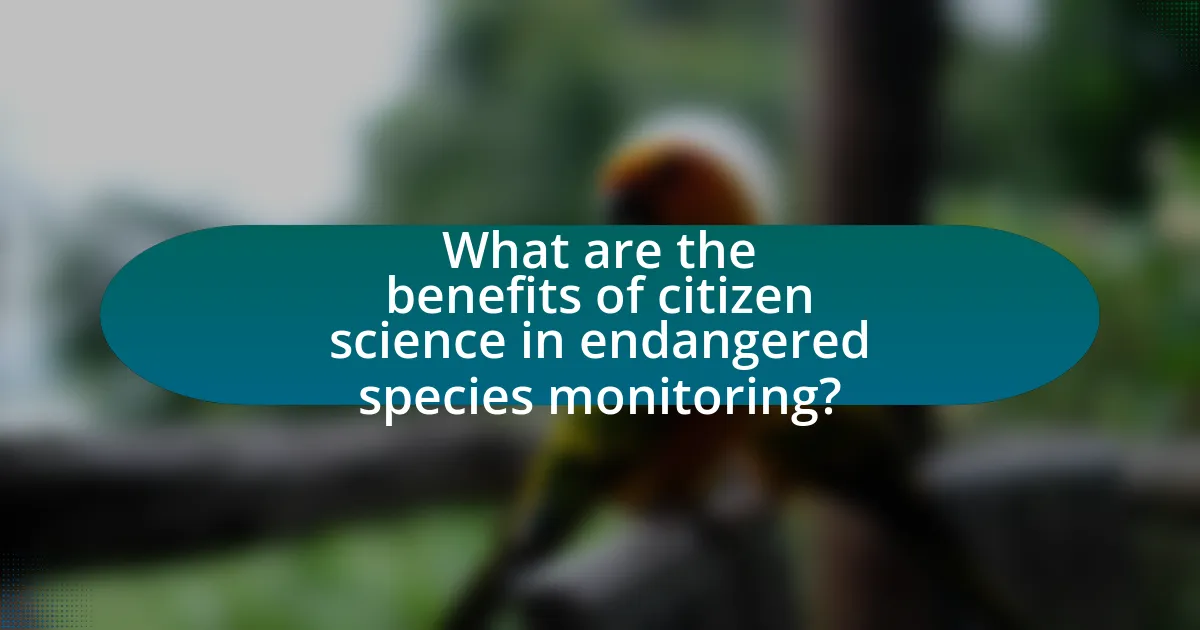
What are the benefits of citizen science in endangered species monitoring?
Citizen science significantly enhances endangered species monitoring by increasing data collection efforts and fostering community engagement. This approach allows non-professionals to contribute valuable observations, which can lead to more comprehensive datasets. For instance, a study published in the journal “Biological Conservation” found that citizen scientists provided over 1.5 million records of species sightings, which helped identify critical habitats and population trends. Additionally, involving the public raises awareness about conservation issues, leading to greater advocacy and support for endangered species protection initiatives.
How does citizen science enhance data collection efforts?
Citizen science enhances data collection efforts by mobilizing large numbers of volunteers to gather and analyze data, significantly increasing the volume and diversity of information collected. This approach allows researchers to access data from remote or hard-to-reach areas, as seen in projects like the Audubon Society’s Christmas Bird Count, which has documented bird populations across North America for over a century, yielding critical insights into species trends and habitat changes. Additionally, citizen scientists often contribute local knowledge and context, improving the quality and relevance of the data collected, which is essential for effective monitoring of endangered species.
What types of data can citizen scientists provide?
Citizen scientists can provide various types of data, including species observations, habitat assessments, and environmental measurements. These contributions are crucial for monitoring endangered species, as they help gather large-scale data that would be difficult for professional scientists to collect alone. For instance, citizen scientists often report sightings of specific species, which can be used to track population trends and distribution changes over time. Additionally, they can collect data on habitat conditions, such as temperature, humidity, and vegetation types, which are essential for understanding the ecological needs of endangered species. This data is validated through numerous studies, demonstrating that citizen-collected data can be as reliable as that gathered by trained professionals, thereby enhancing conservation efforts.
How does the scale of citizen involvement affect data quality?
The scale of citizen involvement significantly enhances data quality in endangered species monitoring. Increased participation from citizens leads to a larger volume of data collected, which can improve the statistical power and reliability of findings. For instance, a study published in the journal “Biological Conservation” by Conrad and Hilchey (2011) demonstrated that citizen-collected data, when properly managed and validated, can match or even exceed the quality of data gathered by professional scientists. This is particularly evident in large-scale projects where diverse geographic coverage and varied expertise contribute to a more comprehensive understanding of species distribution and behavior. Thus, higher levels of citizen engagement directly correlate with improved data quality in monitoring efforts.
What are the social impacts of citizen science on communities?
Citizen science positively impacts communities by fostering collaboration, enhancing environmental awareness, and empowering local residents. Through participation in data collection and research, community members develop a sense of ownership and responsibility towards their local ecosystems. For instance, studies have shown that citizen science initiatives, such as the Audubon Society’s Christmas Bird Count, not only engage thousands of volunteers but also lead to increased public interest in conservation efforts. Furthermore, citizen science projects often facilitate social interactions and networking among participants, strengthening community ties and promoting collective action for environmental stewardship.
How does citizen science foster community engagement in conservation?
Citizen science fosters community engagement in conservation by actively involving local individuals in data collection and monitoring efforts, which enhances their connection to environmental issues. This participatory approach empowers community members to contribute to scientific research, leading to increased awareness and stewardship of local ecosystems. For instance, studies have shown that projects like the Audubon Society’s Christmas Bird Count engage thousands of volunteers annually, resulting in valuable data that informs conservation strategies while simultaneously educating participants about biodiversity and habitat preservation.
What educational benefits arise from citizen science initiatives?
Citizen science initiatives provide significant educational benefits by enhancing public understanding of scientific processes and fostering critical thinking skills. Participants engage in hands-on data collection and analysis, which promotes experiential learning and deepens their comprehension of ecological and environmental concepts. Research indicates that involvement in citizen science projects increases scientific literacy; for instance, a study published in the journal “PLOS ONE” by Bonney et al. (2014) found that participants reported improved knowledge of scientific methods and environmental issues after engaging in such initiatives. Additionally, citizen science encourages collaboration and communication among diverse groups, further enriching the educational experience.
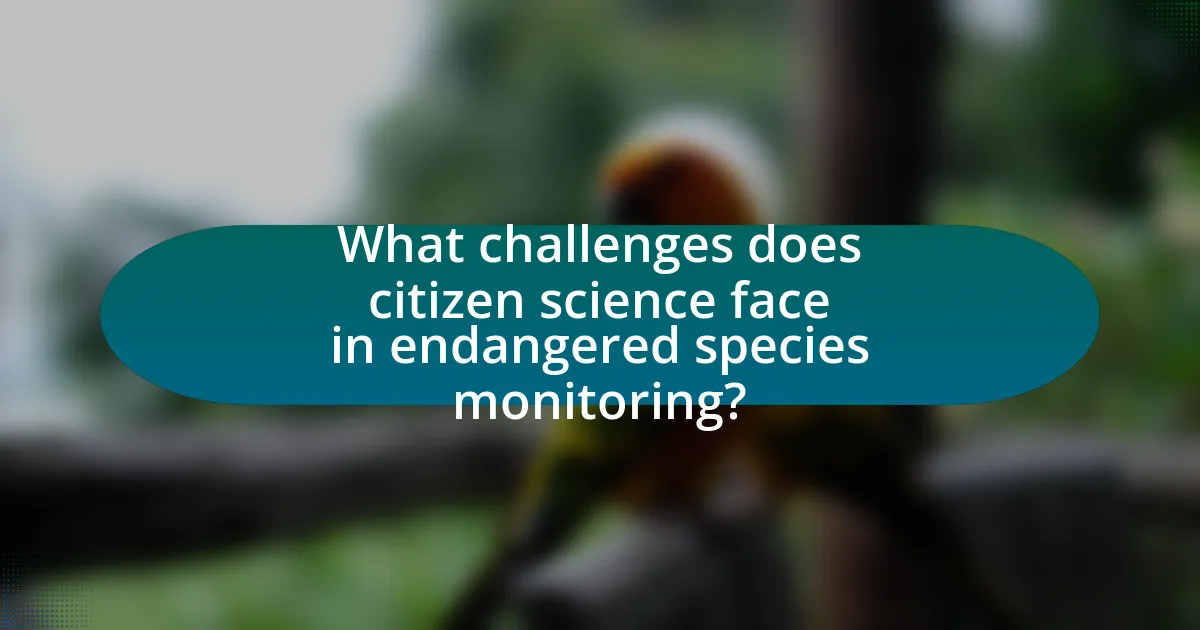
What challenges does citizen science face in endangered species monitoring?
Citizen science faces several challenges in endangered species monitoring, including data quality, participant engagement, and resource limitations. Data quality issues arise from varying levels of expertise among volunteers, which can lead to inaccuracies in species identification and reporting. A study published in the journal “Biological Conservation” highlights that inconsistent data collection methods can compromise the reliability of findings. Participant engagement is crucial, as maintaining motivation among volunteers can be difficult, especially in long-term projects. Additionally, resource limitations, such as funding and access to technology, hinder the ability to train volunteers effectively and provide necessary tools for monitoring efforts. These challenges collectively impact the effectiveness of citizen science initiatives in contributing to endangered species conservation.
What are the limitations of citizen-collected data?
Citizen-collected data has several limitations, including issues of accuracy, representativeness, and data quality. Accuracy can be compromised due to varying levels of expertise among citizen scientists, leading to potential misidentification of species or incorrect data recording. Representativeness is often limited, as data may be biased towards areas with higher volunteer engagement, neglecting less accessible regions. Additionally, data quality can suffer from inconsistent methodologies, as citizens may not follow standardized protocols, resulting in unreliable datasets. These limitations can hinder the effectiveness of citizen science in monitoring endangered species, as highlighted in studies that emphasize the need for training and guidelines to improve data reliability.
How can data accuracy be ensured in citizen science projects?
Data accuracy in citizen science projects can be ensured through rigorous training of participants, standardized data collection protocols, and validation processes. Training equips volunteers with the necessary skills to accurately observe and record data, while standardized protocols minimize variability in data collection methods. Validation processes, such as cross-referencing citizen-collected data with expert assessments or using automated tools for error detection, further enhance accuracy. Research indicates that projects employing these strategies, like the Cornell Lab of Ornithology’s eBird platform, have successfully maintained high data quality, with studies showing over 90% accuracy in species identification by trained volunteers.
What are the potential biases in citizen science data collection?
Potential biases in citizen science data collection include selection bias, reporting bias, and observer bias. Selection bias occurs when participants self-select into projects, often leading to a non-representative sample of the population, which can skew results. Reporting bias arises when volunteers may only report certain observations, influenced by their interests or knowledge, thus omitting critical data. Observer bias happens when individual perceptions or experiences affect data collection, leading to inconsistencies in how observations are recorded. Studies have shown that these biases can significantly impact the reliability of data, as evidenced by research indicating that citizen-collected data often underrepresents certain species or habitats due to these biases.
How can citizen science initiatives be improved?
Citizen science initiatives can be improved by enhancing participant training and engagement. Providing comprehensive training ensures that volunteers understand the scientific methods and data collection processes, which increases the quality and reliability of the data gathered. For instance, studies have shown that well-structured training programs lead to a 30% increase in data accuracy in biodiversity monitoring projects. Additionally, fostering a sense of community among participants through regular communication and feedback can boost motivation and retention, ultimately leading to more sustained involvement in monitoring endangered species.
What training and resources are necessary for effective citizen participation?
Effective citizen participation requires training in data collection methods, species identification, and ethical research practices, along with access to resources such as field guides, online databases, and communication platforms. Training equips citizens with the necessary skills to accurately monitor and report on endangered species, ensuring data reliability. Resources like field guides provide essential information on species characteristics, while online databases facilitate data submission and sharing. Communication platforms enhance collaboration among participants, fostering a community of practice that supports ongoing learning and engagement in conservation efforts.
How can collaboration with scientists enhance citizen science projects?
Collaboration with scientists enhances citizen science projects by providing expertise, resources, and validation of data collected by non-professionals. This partnership allows citizen scientists to receive guidance on research methodologies, ensuring that data collection is scientifically sound and relevant. For instance, a study published in the journal “Frontiers in Ecology and the Environment” by Bonney et al. (2014) highlights that scientists can help design effective protocols that improve the quality of data gathered, which is crucial for monitoring endangered species. Additionally, scientists can assist in analyzing the data, leading to more accurate conclusions and actionable insights for conservation efforts. This collaboration ultimately strengthens the credibility and impact of citizen science initiatives in addressing environmental challenges.
What are best practices for engaging citizens in species monitoring?
Best practices for engaging citizens in species monitoring include providing clear guidelines, utilizing technology for data collection, and fostering community involvement. Clear guidelines ensure that participants understand their roles and the importance of accurate data collection, which enhances the reliability of the monitoring efforts. Technology, such as mobile apps and online platforms, facilitates easy data submission and real-time feedback, making participation more accessible and engaging. Community involvement, through workshops and local events, builds a sense of ownership and responsibility among citizens, which has been shown to increase participation rates and data quality in studies like those conducted by the National Audubon Society, which reported a 30% increase in citizen engagement when local events were organized.
How can technology be leveraged to facilitate citizen involvement?
Technology can be leveraged to facilitate citizen involvement by providing accessible platforms for data collection, communication, and collaboration in conservation efforts. For instance, mobile applications and online databases enable citizens to report sightings of endangered species, contributing valuable data to researchers. A study by Theobald et al. (2015) in “Citizen Science: Theory and Practice” highlights how technology enhances participation by allowing real-time data sharing and fostering community engagement in monitoring efforts. This integration of technology not only empowers citizens but also enriches scientific research with diverse observations and insights.
What strategies can be employed to sustain long-term citizen engagement?
To sustain long-term citizen engagement, organizations should implement strategies such as continuous education, regular feedback mechanisms, and community-building activities. Continuous education ensures that citizens are informed about the importance of their contributions to endangered species monitoring, fostering a sense of purpose. Regular feedback mechanisms, such as surveys and updates on project outcomes, keep participants informed about the impact of their involvement, reinforcing their commitment. Community-building activities, including workshops and social events, create a supportive network among participants, enhancing their connection to the cause. Research indicates that these strategies lead to higher retention rates in citizen science projects, as seen in studies conducted by the National Academies of Sciences, Engineering, and Medicine, which highlight the importance of sustained engagement for effective conservation efforts.
